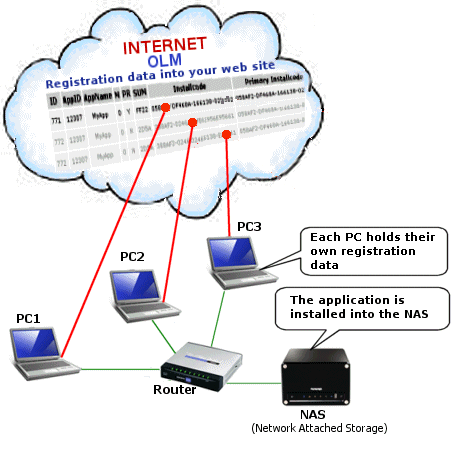Items
AVLock SIMPLE can be configured on several ways in order to adapt them to your specific needs.
NETWORK CONFIGURATION
Below you can see three common configurations:
1. SAN (Storage Area Network)
In this case, we install a single copy of the application on the network, the computer where you install it is called "The server" and must make a single registration from the server and other computers read the registration data from the only existing copy on the server. See the diagram below:

In this case the application must be registered only once from the server. There will be only one installation of the application and one copy of the registration data in the folder of the application on the server.
2. NAS (Network Attached Storage)
NAS is a data storage device that is installed on the network so it is available from any computer connected to the network. This configuration is very practical because unlike the SAN configuration this does not require a computer always on.
In this case you install a single copy of the application on the NAS. Here, unlike the previous case can not be saved the registration data into the NAS storage device so we will have a separate registration for each computer, located in a special Windows folder for this purpose, according to the value for the RegPath property which could be CommonDocuments, ProgramData, or LocalAppData RoamingAppData.

3. REMOVABLE (Removable storage like Pen Drive, memory stick and removable disk)
In this case the application and registration data must be placed in the same folder of the application such as for the SAN configuration. But in this case InstallCode should not vary by changing the removable device from one computer to another, this is achieved by assigning to the property (RemovableDisk: = True). Thus the Installcode be calculated solely based on a code obtained from the removable device. It will install and register the application once and this may be used from any computer.
Please see into the examples the following directive in order to define AVLock SIMPLE according with your network configuration and how this is used into the GetRegStatus method.
{$DEFINE SAN} //Options are NAS, SAN, REMOV
// NAS = Network Attached Storage
// SAN = Storage Area Network
// REMOV = Removable Disk
procedure TRegForm.GetRegStatus;
var s:string;
begin
AVLock:= Form1.AVLockS51;
with avlock do begin
{$IFDEF NAS}
RegPath := CommonDocuments;
RegFolder := 'example1';
InstancesCtrl := False;
{$ENDIF}
{$IFDEF SAN}
RegPath := ExeDir;
RegFolder := '';
InstancesCtrl := True;
{$ENDIF}
{$IFDEF REMOV}
RegPath := ExeDir;
RegFolder := '';
InstancesCtrl := False;
RemovableDisk := True;
{$ENDIF}
OLM CONFIGURATION
On relation to the OLM (Online license Manager) there are three possible configurations, namely:
1. Basic OLM
This OLM version is provided with all commercial versions of AVLock SIMPLE and allow to manage the trial generation and control. For more details see The Online License Manager (OLM).
2. Advanced OLM
This OLM version is provided with the professional and developer versions of AVLock SIMPLE. Allow you to accomplish the whole licensing cycle for your application namely; start the trial period, extend the trial period, activate your application by the user, and move the license to another computer. The examples shows how to implement each one of these steps. For more details see The Online License Manager (OLM).
3. No OLM
With this option the OLM will be never used. The trial period will be started using the MakeTrial method and licenses granted through keys sent to the user according with the license purchased. All the process are accomplished off line.
Please see into the examples the following compiler directive in order to define the OLM configuration, and how this is used to start the trial period and remove the registration data:
{$DEFINE BASIC_OLM} //Options are BASIC_OLM, ADVANCED_OLM, NO_OLM
procedure TRegForm.BtnTrialClick(Sender: TObject);
var res:string;
err:integer;
begin
if (keydata.Status = Unregistered) then
begin
res:='';
{$IFDEF NO_OLM}
//(index,users,inst,startdate,days,values)
err:=AVLock.MakeTrial(0,1,2,date,30,'000');
if (err=0) then res:='00';
{$ENDIF}
{$IFDEF BASIC_OLM}
//values, kind, Index, days, inst)
res := AVLock.OnlineGetKeyB('000',0,0,30,1);
{$ENDIF}
{$IFDEF ADVANCED_OLM}
//(index,users,inst,days,values)
res := AVLock.OnlineStartTrial(0,1,1,30,'000');
{$ENDIF}
...
procedure TRegForm.BtnRemoveLocalClick(Sender: TObject);
var ok:boolean;
s,msg:string;
begin
if AVLock.EraseReg
then msg:= 'Local registration data removed'+#13#10
else msg:= 'Could not remove Local registration data'+#13#10;
ok:=False;
{$IFDEF BASIC_OLM}
ok:= AVLock.OnlineRemoveKey(0); //remove regitration data from the Basic OLM
{$ENDIF}
{$IFDEF ADVANCED_OLM}
s:= AVLock.OnlineRemoveReg(0); //remove regitration data from the Advanced OLM
ok:= ((s='00') or (s='11'));
{$ENDIF}
...
I tried to make this help as clear and complete as possible, however they may have some issues not covered by this documentation. If you think I have missed something, or found errors, or have any idea that might be useful to improve this help, please let me know.
Alcides Valega Author of AVLock SIMPLE |